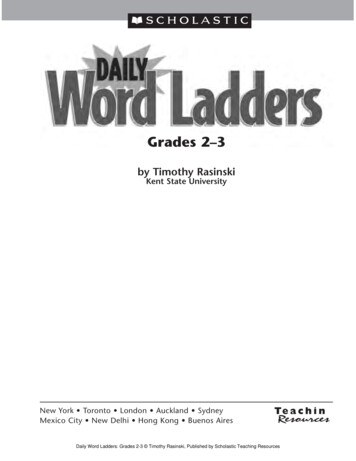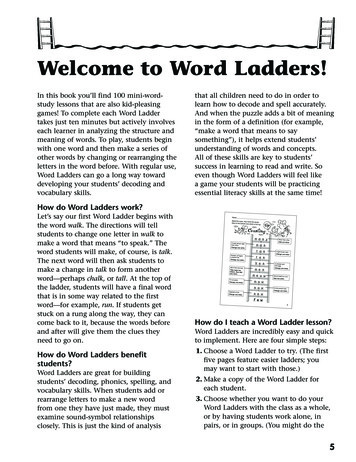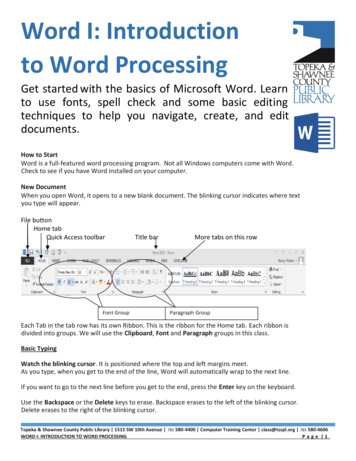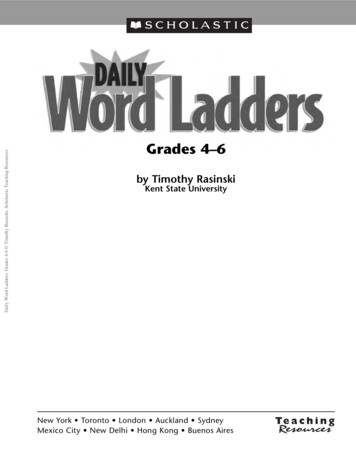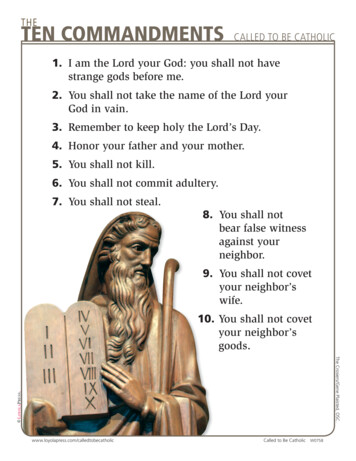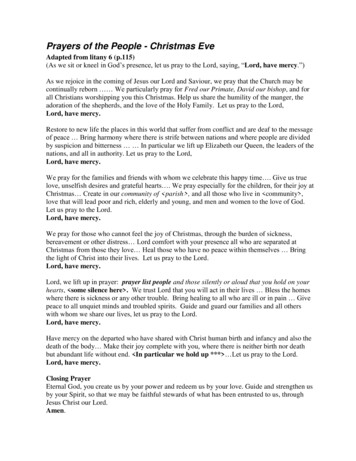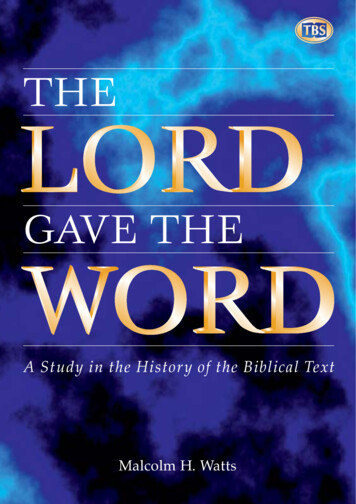
Transcription
A Study in the History of the Biblical TextTHELORDGAVE THEWORDA Study in the History of the Biblical TextMalcolm H. WattsTrinitarian Bible SocietyWilliam Tyndale House, 29 Deer Park RoadLondon SW19 3NN, Englandi
Product Code: A111ISBN 978 1 86228 011 3 Trinitarian Bible Society 1998William Tyndale House, 29 Deer Park Road, London SW19 3NN, EnglandRegistered Charity Number: 233082 (England) SC038379 (Scotland)Copyright is held by the Incorporated Trinitarian Bible Society Truston behalf of the Trinitarian Bible Society
ContentsThe Old Testament1122344456677891011The New Testament1213131415The first languageWriting materialsRevelationTwin doctrineWrittenThe OriginalsThe TempleSignificance of the ArkOne BookCopiesThe work of scribesLoss of the originalsThe Great SynagogueThe Famous MassoretesThe Massoretic TextOld Testament SummaryChristian truth written downThe Divine OriginalsAccurate CopyingTextual VariantsReproducing the authenticNew Testament TextThe Surviving Greek manuscripts1. Papyri2. Uncials3. Minuscules4. LectionariesClassificationA. Byzantine Text-typeB. The Alexandrian Text-typeCritics attack the Byzantine TextThe Authorised VersionEndnotes161717181919202124252728
A Study in the History of the Biblical TextTHELORDGAVE THEWORDA Study in the History of the Biblical TextMalcolm H. WattsThe Bible is the eternal Word ofGod. It has been given by God toman that it might be the absolute,supreme, authoritative, infallible, and unchangeable standard for faith and practice.In this article we shall trace the historyof the Bible from its origin in divine selfrevelation, through its embodiment inwritten form by supernatural inspiration,to its accurate transmission to this presentage by providential preservation. It is ourfirm belief that, although the storms ofcriticism continue to rage against God’sWord, the humble believer’s confidence init is justifiable and substantiated. Thissacred volume is – and always will be – theBook of God.from the old Hebrew spoken by Abraham in Ur of the Chaldees (Genesis14:13) and a number of scholars believe that this old Hebrew predatedAbraham and that it was the “onelanguage” and “one speech” of preBabel times (Genesis 11:1). In otherwords, they believe it was the originallanguage of man.THE FIRST LANGUAGESupporting evidence for this viewis quite substantial. First of all, in Hebrew the names of animals expressvery accurately their nature andcharacteristics – more so, indeed, thanin any other ancient language. Thiswould tie in with the fact that Adam,soon after his creation, gave names tothe animals by observing the peculiarqualities and characteristics of eachspecies (Genesis 2:19-20). Second,proper names, like Adam, Eve, andCain, have significant meanings inHebrew, some of which are actuallyThe Old TestamentThe greater part of the Old Testamentwas written in Hebrew, sometimescalled “the language of Canaan”(Isaiah 19:18) or “the Jews’ language”(Isaiah 36:11). It probably developed1
T H E LORD GAVE THE WORDWe know that papyrus was used inEgypt long ago, certainly in the timeof Moses, and it is therefore likely thatthe first documents of the Old Testament were written on this material.If not, they would have been writtenon animal skins which were beingused around 2000 BC. Skins cameto be preferred because they lastedlonger and proved not to be so brittle:hence, they preserved the text moreAn argument can therefore be perfectly.made for some form of Hebrew having been the first language spokenEVELATIONand heard in this world; but be thatWe know that God is the greatestas it may, it is an indisputable fact thatpractically the whole of the Old Testa- of beings. Scripture says, “Canst thoument is written in Hebrew. The only by searching find out God? canst thouexceptions are in Aramaic (a close, cog- find out the Almighty unto perfecnate language to Hebrew) which did, tion?” (Job 11:7). And the answerin fact, supersede Hebrew at the time assumed is, of course, No. We cannotof the captivity. These exceptions are with all our ingenuity discover thetwo parts of the book of Ezra (4:8-6:18; infinite God. He is far, far above our7:12-26), accounted for by Aramaic human comprehension. Does thisbeing the official language of the mean, then, that we have no hope ofPersian Empire; a verse in Jeremiah knowing Him? Thankfully, it does(10:11), where there is a quotation of not mean that. Although we canan Aramaic proverb; and quite a large not – even with intense investigationsection of the book of Daniel (2:4 to – discover God, He is able to make7:28), where Aramaic is used, probably Himself known to us. As the sourcebecause the entire section deals with of all truth, He can teach us about Hisown wonderful Being; and therefore,the nations of the world.as the Psalmist says, “In thy light shallwe see light” (Psalm 36:9). This bringsRITING MATERIALSus, quite naturally, to the doctrine ofNow on what were the ancient revelation.Scriptures written? Originally, theA concise, but accurate, definitionOld Testament Scriptures appear tohave been written on papyrus. This of revelation comes from the pen of Dr.was made from reeds which grew on James Bannerman. He wrote: “Revelathe banks of the Nile River. The reeds tion, as a divine act, is the presentationwere cut into strips and placed line of objective truth to a man in a superupon line at right angles: then, they natural manner by God. Revelation,were beaten, pressed, and polished as the effect of that act, is the objectiveto form a kind of primitive paper. truth so presented”.1assigned to them in the Old Testament Scriptures (Genesis 2:23; 3:20;4:1). Third, the names of variousancient nations appear to be of Hebrew origin, being derived from thesons and grandsons of Shem, Hamand Japheth: as, for example, theAssyrians from Ashur; the Elamitesfrom Elam; and the Aramaeans fromAram.RW2
A Study in the History of the Biblical TextNow revelation is of two kinds.First of all, there is general revelation.This comes partly from outside us,from the world round about us. Inthe works of creation and providence,God shows something of His divinity and perfection. “For the invisiblethings of him from the creation of theworld are clearly seen, being understood by the things that are made,even His eternal power and Godhead”(Romans 1:20; cf. Psalm 19:1; Acts14:27). Looking at the various parts ofthis visible universe, we are compelledto think, with reverential awe, of thedivine Architect and Maker. Furthergeneral revelation comes from insideus. Made in the image of God, we havesome natural sense of God, immortality, and the difference between rightand wrong. We are, as Paul says, alaw unto ourselves because “the workof the law” is written in our “hearts”,our “conscience also bearing witness”(Romans 2:14,15).special revelation came to chosen menthrough visions, dreams, and burdens.As God Himself once said, “If therebe a prophet among you, I the LORDwill make myself known unto him ina vision, and will speak unto him in adream” (Numbers 12:6). “Burdens”were heavy messages laid upon themind and heart. Hence, we read:“The burden of the word of the LORDto Israel by Malachi” (Malachi 1:1).Special revelation meets the deepestneeds of men’s hearts. It answersthe question which is as old as man’ssoul – “How should man be just withGod?” (Job 9:2).Through general and special revelation (which climaxed, of course, inthe Incarnation), God has graciouslygiven to us a divine self-disclosure andmade known the way of His salvation.TWIN DOCTRINEThere is a twin doctrine which wenow need to consider: inspiration,which Professor Louis Gaussen oncedefined as “that inexplicable powerwhich the Divine Spirit put forth ofold on the authors of holy Scripture,in order to their guidance even in theemployment of the words they used,and to preserve them alike from allerror and from all omission”.2Such revelation is said to be general: not only because it is generallymade throughout the world, but alsobecause it deals only with generalthings. It says nothing about specifics, like reconciliation with God, theforgiveness of sins, or the way toheaven.However, in His wonderful mercy,God has been pleased to grant specialrevelation. This, too, is both externaland internal. External special revelationcame through “theophanies” as God actually appeared to men and also through“voices”, as God spoke to them. “TheLORD appeared unto Abram, and said,Unto thy seed will I give this land ”(Genesis 12:7; cf. 3:8-19). InternalInspiration, then, is the processby which God exerts a supernaturalinfluence upon certain men, enablingthem accurately and infallibly torecord whatever has been revealed.“Holy men of God”, we read, “spakeas they were moved by the HolyGhost” (2 Peter 1:21). The result ofthe process is the written Word of3
T H E LORD GAVE THE WORDGod, “the scripture of truth” (Daniel10:21). The apostle’s classic statementimmediately comes to mind: “All scripture is given by inspiration of God”(2 Timothy 3:16).it in [or, by] the side of the ark of thecovenant of the LORD your God, thatit may be there for a witness againstthee” (cf. Joshua 1:8; 1 Kings 2:3;Nehemiah 8:1).Inspired Scripture is God’s bookof revelation. As a result of revelationand inspiration, we are able to holdthe Bible in our hands and know thatwe have in our possession the writtenWord of God.After Moses came Joshua, the author of the book which bears his name;and towards the end of his life, according to Joshua 24:26, he did exactly asMoses had once done. Having madean addition to Moses’ scroll, he hadthat scroll replaced in the sanctuary.“And Joshua wrote these words in theRITTENbook of the law of God, and took aThe first recorded example of great stone, and set it up there undersuch writing is found in Exodus 17:14 an oak, that was by the sanctuary ofwhere, soon after the war with the the LORD”.Amalekites, the Lord said to Moses:“Write this for a memorial in a book ”It was not long before there was aAgain, in Exodus 24:4, we read how further addition, this time by Samuel,“Moses wrote all the words of the who “told the people the manner ofLORD”. And yet again, in Exodus 34:27, the kingdom, and wrote it in a book,the Lord said to him, “Write thou these and laid it up before the LORD” (i.e., inwords ” And so we could proceed. God’s presence, in the holiest apartThere are many other passages show- ment and by the ark of the covenant;ing that Moses wrote more, much 1 Samuel 10:25).more, even the whole of the Pentateuch, i.e., the first five books of theHE EMPLEBible (e.g., Deuteronomy 31:9,24-26;Numbers 33:1,2).When the tabernacle was changedfor the temple, these precious originalsappear to have been transferred toHERIGINALSthe more permanent building. ThereOnce written, the inspired origi- may be a reference to them in 2 Kingsnals, or “autographs” (as they are 22:8, where Hilkiah, the high priest, iscalled), were most carefully preserved. recorded as saying, “I have found theMoses’ scroll, for example, was com- book of the law in the house of themitted to the priests who deposited LORD”. Some scholars have suggestedit near the sacred ark. We read in that this “book of the law” was Moses’Deuteronomy 31:25,26 that “Moses original copy, hidden by the priestscommanded the Levites, which bare during the wicked reigns of Manassehthe ark of the covenant of the LORD, and Amon and only now discoveredsaying, Take this book of the law [the and brought to the king’s attention.3book which he had written] and put In 2 Chronicles 34:14, it is called “aWTTO4T
A Study in the History of the Biblical Textbook of the law of the LORD given byMoses”. A more literal translationwould be “the book of the law of theLORD by the hand of Moses”.precepts. Every soul of man must bowto it. “For he established a testimonyin Jacob, and appointed a law in Israel,which he commanded our fathers, thatthey should make them known to theirchildren ” (Psalm 78:5).SIGNIFICANCE OF THE ARKDr. W. H. Green points out thatkeeping these documents in thisholy place was “in accordance withthe usage of the principal nations ofantiquity”. He alludes to the fact that“the Romans, Greeks, Phoenicians,Babylonians, and Egyptians had theirsacred writings, which were jealouslypreserved in their temples, and entrusted to the care of officials speciallydesignated for the purpose”.4Furthermore, since these Scriptures were placed near the ark, inthe heart of the tabernacle or temple,they were separated from all commonbooks. They were manifestly declaredto be holy. Certainly, God’s writtenWord is pure and sublime. It is truth,without any mixture of error. “Thewords of the LORD are pure words:as silver tried in a furnace of earth,purified seven times” (Psalm 12:6).The inspired writings should alwaysThere were, however, more impor- be revered as “the holy scriptures”tant reasons why the scrolls were laid (2 Timothy 3:15).up in this place:The ark, of course, had its mercyThe ark was enshrined in the di- seat whereon sacrificial blood wasvine sanctuary; and writings placed sprinkled (Exodus 25:21); and theat the side of the ark were therefore books were placed nearby, intimatingpeculiarly associated with God. He is perhaps that they explained the docindeed the author of the Scriptures. trine of atonement and set forth theWhat He has said and what the Scrip- only way of approach to God. “Thus it istures say are one and the same thing written, and thus it behoved Christ to(Romans 9:17; Galatians 3:2). Here, suffer, and to rise from the dead thethen, is God’s written Word and, as a third day: and that repentance andwhole, these inspired books may be remission of sins should be preachedcalled “the oracles of God” (Romans in his name ” (Luke 24:46,47).3:2; cf. Acts 7:38).One final thought: the scrollsPious Israelites understood the would have been under the wingsark to be the throne of God (Exodus of the Cherubim (Exodus 25:18-20),25:22; Psalm 80:1). The fact that an indication of their being divinelythese writings were placed by the safeguarded and preserved. Althoughark suggested that they were divinely often denied today, the doctrine ofauthoritative. Scripture possesses the preservation of Scripture is to betremendous authority. It demands believed and boldly declared. “Theof men unhesitating faith in its teach- Old Testament in Hebrew and theings and unfaltering obedience to its New Testament in Greek being5
T H E LORD GAVE THE WORDimmediately inspired by God, andby His singular care and providencekept pure in all ages, are thereforeauthentical” (The Westminster Confession of Faith, Chap. 1; Sect. 8). OurLord Himself said: “Till heaven andearth pass, one jot or one tittle shallin no wise pass from the law, till allbe fulfilled” (Matthew 5:18; cf. Psalm119:152; Isaiah 40:8).then that God laid down the rule forcopying: the copy must be “accordingto the first writing” (Deuteronomy10:4). And we have solid grounds forbelieving that this rule was strictlyenforced. When Jeremiah’s writtenmessage was destroyed by King Jehoiakim, God told the prophet tomake another copy but, in doingso, he stipulated that it had to be anexact copy. “Take thee again anotherroll”, he said, “and write in it all theformer words that were in the firstroll” (Jeremiah 36:28). Accordingly,Baruch (Jeremiah’s scribe) rewrote,under the prophet’s dictation, all thewords which had been written on theformer scroll (36:32 – the second scrollwas therefore an accurate copy of thefirst, even though on this occasionBaruch added further material fromJeremiah’s inspired ministry).ONE BOOKGod continued to inspire men untilthere was a wonderful collection ofbooks (1 Chronicles 29:29; 2 Chronicles 9:29, 12:15; Isaiah 30:8; Jeremiah36:1,2). The earliest of Moses’ writings would be dated about 1450 BC,while Malachi’s writing would havebeen finished somewhere around450 BC. So it was for approximately1,000 years that God graciously communicated with men and, by thesupernatural influence of His Spirit,caused His communications to bewritten down, free of all error in bothfact and doctrine. These writings werethen wonderfully preserved. It onlyremains for us to observe here that,from the beginning, this collectionwas regarded as essentially one book,called “the book of the LORD” (Isaiah34:16).So copies were made, not only ofthe Ten Commandments but also ofother parts of Scripture. A copy ofthe book of Deuteronomy, or perhapseven the whole Pentateuch, was to bein the hands of every king of Israel.“He shall write him a copy of this lawin a book out of that which is before thepriests the Levites: and it shall be withhim and he shall read therein all thedays of his life” (Deuteronomy 17:18;cf. 2 Chronicles 23:11). The originals,of course, were in the charge of “thepriests the Levites”; and when it says,“he shall write him a copy”, it probablydoes not mean that he himself shoulddo this but that he should arrange forsomeone to do it for him (cf. 1 Samuel1:3; 13:9; 1 Kings 8:62; John 19:19,where certain men are said to do what,in the event, was almost certainly doneby others).COPIESThe first time copying is mentionedis with respect to the Ten Commandments, originally written of courseon tablets of stone by the finger ofGod. Those first tablets having beenbroken, the Lord commanded Mosesto chisel out new tablets and the Lordwrote on them the same words. It was6
A Study in the History of the Biblical TextIn order to function properly,judges would have needed access tothe various laws of Moses (2 Chronicles 19:10), as would the priests,especially those sent with certainLevites to teach in the cities of Judah(2 Chronicles 17:7-9). In the latter case,it is specifically said that “they taughtin Judah, and had the book of the lawof the LORD with them” (v 9). We arenot to suppose that only officials possessed copies of the Scriptures. Thereis evidence to suggest that believersgenerally had access to biblical books(Psalm 1:4, Psalm 119).themselves into “families” or “guilds”,combining their efforts to ensure thebest possible results (1 Chronicles2:55). Their expertise in this field, together with their profound reverencefor Holy Scripture, meant the production of really excellent copies. In fact,only the scrolls which proceeded fromthis class of scribes were relied upon.THE WORK OF SCRIBESSuch accuracy was achieved thatthe scribes’ copies could be cited asthe very Word of God and thereforedivinely authoritative. In 1 Kings2:3, David commands Solomon, hisson: “Keep the charge of the LORD thyGod, to walk in his ways, to keep hisstatutes, and his commandments, andhis judgments, and his testimonies, asit is written in the law of Moses”. NowKing Solomon would only have hadaccess to a copy, such as is mentionedin Deuteronomy 17:18,19; but observehow this copy is described as what is“written in the law of Moses”. Suchpainstaking care had taken over thecopying that the resultant manuscriptretained the authority of the original.It was the Word of God and it couldbe cited as such.It is worthy of note just here that,in the purpose and providence of God,the Jews took greater care of their sacred writings than any other people inthe ancient world.Originals, as we have alreadyobserved, are called “autographs”.Copies are known as “apographs”.It is clear that great care was takenin copying the Scriptures. At first,the priests were responsible for this(Deuteronomy 17:18) but later scribes(Hebrew: sopherim, from saphar,to write) assumed this role, as thelanguage of Jeremiah, the prophet,indicates: “How do ye say, the lawof the LORD is with us? Lo, certainlyin vain made he it; the pen of scribesis in vain” (Jeremiah 8:8). Thosedesignated as scribes originally hadmany and various responsibilities.However, as time went on, theytended to concentrate on the work oftranscription: and hence a man likeEzra came to be called “a scribe of theOSS OF THE ORIGINALSwords of the commandments of theJerusalem fell to the BabyloniansLORD, and of his statutes to Israel”in 586 BC. The city suffered dreadful(Ezra 7:11).damage and the great temple built byUnderstandably, the demand for Solomon was completely destroyedcopies of the Scriptures became very (2 Chronicles 36:17-19). Although notgreat. The scribes therefore formed mentioned in the history, it is almostL7
T H E LORD GAVE THE WORDcertain that the original writings perished along with the city. However, allwas not lost. By that time numerouscopies had been made and some ofthese were taken into the land of captivity; for we find Daniel quoting fromwhat must have been a copy of Moses’Law (Daniel 9:11) and also makingmention of Jeremiah’s prophecy, acopy of which must also have been inhis possession (9:2).was – consisted of 120 members andcame to include the prophets Haggai,Zechariah and Malachi. The “Menof the Great Synagogue” collectedtogether all copies of Holy Scripturewhich they could find. These, theysubjected to detailed examinationand comparison. Many minor errors,inadvertently made, were now corrected. These errors were such as theomission of a letter, a word, or perhapseven a line. That they had crept intosome manuscripts is not at all surprising when we remember that there areat least eight pairs of Hebrew letterswhich are similar, even to the point ofbeing nearly identical. The most conscientious of scribes was not beyondmaking a small mistake. Eventually, however, the copies underwentcorrection and if any were foundparticularly faulty, they were buriedin a “genizah”, a holy place near to aJewish synagogue. As a result of theGreat Synagogue’s work, the SecondTemple appears to have been suppliedwith a text very similar to the later,received Hebrew text.5In 537 BC, the Jews began to returnfrom their captivity and we knowthat Ezra re-established worshipin Jerusalem “as it is written in thebook of Moses” (Ezra 6:18). This suggests that they still had copies of theScriptures and that they were able toconsult them when arranging worshipfor the second temple. According toNehemiah 8:1, the people actuallyrequested Ezra to bring “the book ofthe law of Moses, which the L ORDhad commanded to Israel”. This wasnot the original – only a copy – yet itis significantly described as “the lawof Moses”. We conclude from suchScriptures that God had wonderfullypreserved His Word.By the time our Lord came onthe scene, many reliable copies wereavailable. The Lord Jesus constantlyappealed to the sacred Scriptures. Heread from them in the synagogues(Luke 4:16); He quoted from them inHis public ministry (Matthew 19:35; 21:16,42); and He exhorted Hishearers to read them for themselves(John 5:39). There can be no doubtthat He regarded the extant copies asthe very Word of God. Although Hecorrected Pharisaical interpretationsand glosses, never once did He call intoquestion the integrity of the Hebrew text.He was able to say, “It is written”THE GREAT SYNAGOGUEThe history of the Old Testamentends rather abruptly with the returnfrom captivity; but, according to thelater books, Ezra appears to have assumed presidency of a body of learnedand wise men (Nehemiah 8:4,7,13; cf.Ezra 7:6,11,22). Jewish tradition informs us that, after the Jews returned,Ezra called into being the Great Synagogue with a view to re-organizingthe religious life of the nation. Thiscouncil – for that is what it really8
A Study in the History of the Biblical Text(Matthew 4:4,7,10) and, again, “the to you the holy things of David, thescripture cannot be broken” (John sure things”).10:35). The same applies, of course,Furthermore, the purpose behindto the Apostles (Acts 1:16, 4:25, 28:25;quoting the Septuagint Version isHebrews 1:1,6,7; etc.).often to bring out more clearly theIt might be argued that this proves intended meaning of the original (See:too much, insofar as the Septuagint Romans 10:18, where the rendering(LXX: the Greek translation of the “sound” is preferred to the HebrewOld Testament made by Alexandrian “line”, a somewhat obscure expression,Jews around 250 BC) is also constantly although as a “string” of a musicalquoted in the New Testament, without instrument, it clearly means much theever once being called into question. same thing).On the same premise, therefore, could“We do not find”, commentsthis not be said to indicate endorsement of the Septuagint as an inspired Dr. Roger Nicole, “any example ofand accurate text? No, there is a seri- a New Testament deduction or apous flaw in such reasoning. The fact is plication logically inferred from thethat there are a number of places in the Septuagint and which cannot beNew Testament where the Septuagint maintained on the basis of the Hebrewversion appears to have been delib- text”. He concludes: “The use of theerately rejected (e.g., Matthew 2:15, LXX in quoting does not indicatewhere the LXX reads: “Out of Egypt that the New Testament writers haveI called his children”; Romans 10:15, thought of this version as inspired inwhere the LXX reads, “I am present itself Yet their willingness to makeas a season of beauty upon the moun- use of the LXX, in spite of its occasionaltains, as the feet of one preaching glad defects, teaches the important lessontidings of peace, as one preaching that the basic message God purposedgood news”. See also: Romans 11:4; to deliver can be conveyed eventhrough a translation, and that appeal1 Peter 4:8).can be made to a version insofar as itWhile some New Testament agrees with the original”.6quotations show preference for theSeptuagint rendering, the variationTo return to our earlier point: thein these cases will be found to be very endorsement given by our Lord andslight, and not at all in sense (e.g., His apostles to the first-century HeMatthew 15:8,9 - Hebrew: ”.their brew text shows that text to have beenheart they have removed far from me, both accurate and reliable.and their fearing of me has become aprecept of men, a thing taught”; ActsHE AMOUSASSORETES13:34 - Hebrew: “I will give you thesure mercies of David”, but the NewAs we have seen, God raised upTestament Greek text actually quotes scribes, or sopherim, to produce athe Septuagint here, as in the margin of remarkably pure text. It fell to othersour Authorised Version: ”[I will give] to continue their work and take theT9FM
T H E LORD GAVE THE WORDnecessary steps for the text’s preservation. These were the Massoretes,a name derived from the Hebrewword “Massorah” which means“tradition”. They were families ofJewish scholars and textual criticswho eventually opened academies,one at Tiberius (on the coast of thesea of Galilee) and another in Babylon(in the East). No-one knows exactlywhen the Massoretes first appeared.Some believe they can be traced backto the first century AD. Others datetheir beginnings later, somewherearound 500 AD. Whichever is correct,the Massoretes’ achievement is whatreally matters.Jerusalem had been destroyed inAD 70. As a result, the Jews were scattered throughout the various countriesof the Roman Empire. The Massoretesknew that these dispersed Jews andtheir succeeding generations wouldrequire copies of the Holy Scripturesand they believed that certain thingscould be done to ensure the preservation of the pure Hebrew text. Withthis in mind, they collected vitalinformation about the text and laiddown detailed rules for the propercopying of it.They introduced vowel-points(Hebrew has no vowels), fixed accents(to ensure correct pronunciation), explained the meaning of words (whereambiguity existed), supplied marginalreadings (to remove obscurity), andmarked intended pauses (which oftenaffect the meaning). So meticulouswere they in their studies that theyeven counted the verses, words, andletters of the Old Testament, notingfor example, that Aleph occurs 42,37710times; Beth, 38,218 times; Gimel, 29,537times; and so on.Copyists had to follow the Talmud’s strict rules, which includedthe following: only the skins of cleananimals were to be used; each skinmust contain the same number ofcolumns; there were to be no less thanforty-eight and no more than sixtylines; black ink was to be preparedaccording to a particular recipe; noword or letter was to be written frommemory; if so much as a letter wasomitted, or wrongly inserted, or evenif one letter touched another, the sheethad to be destroyed; three mistakes ona page meant the whole manuscriptwas condemned; and revision of thecopy had to take place within 30 days,for otherwise it had to be rejected.A manuscript surviving this processcould hardly be anything but amazingly accurate.A MASSORETIC TEXTThe Massoretes’ purpose was topreserve the Old Testament fromevery kind of alteration; and it was tosecure that objective that they madetheir collection of detailed notes (theMassorah). The Jews called theirfinished work “The Fence of theLaw”. As a result of their labours,we possess today a standard andtraditional text.The text from which our AuthorisedVersion was translated is called the BenChayyim Text (after Jacob ben Chayyim, under whose editorship it wasprinted in 1524-5) and it is similar tothe Text of Ben Asher (who lived in thetenth century at Tiberius, in Palestine,
A Study in the History of the Biblical Textand who, along with members of hisfamily, established an accurate editionof the Masssoretic Text). This is a faithful and dependable text.of the scribes and Massoretes securedand preserved a pure text. They weregreat scholars, skilled in the divine lawand revered as interpreters of the HolyScriptures.Through God’s special providence,Fifth, there was the oversight ofwe are able confidently to say that inthe Hebrew Massoretic text we have a prophets. Throughout the Old Testext which is very close to the Hebrew tament period, prophets exercised aunique ministry and they were wellOriginal.able to superintend the copying work.Any error in transcription would haveLD ESTAMENTbeen quickly detected by them.OTSUMMARYSixth, the Jews constantly repeatedSumming up, then, what were themeans God used to ensure
The Originals 4 The Temple 4 Significance of the Ark 5 One Book 6 Copies 6 The . would tie in with the fact that Adam, soon after his creation, gave names to . God has been pleased to grant special revelation. This, too, i

